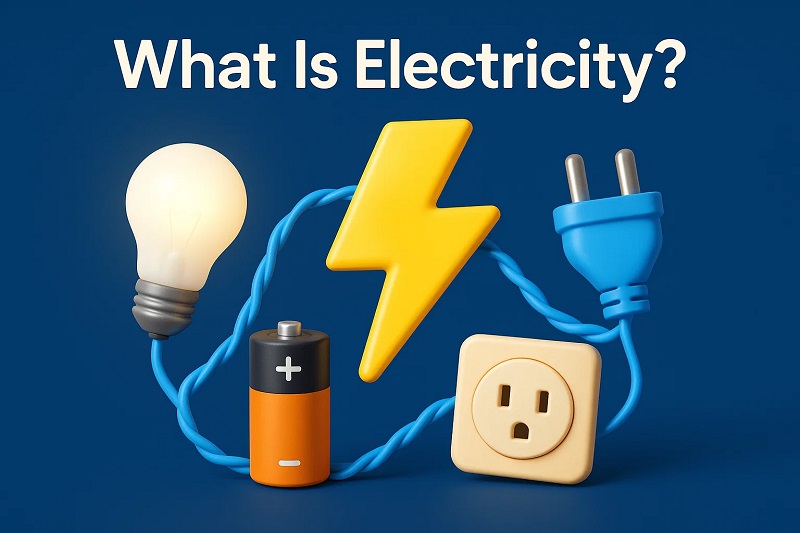
⚡ What Is Electricity? A Beginner’s Guide.
Electricity is one of the most essential parts of our modern world. It powers your lights, your phone, your TV, your refrigerator—nearly everything. But what exactly is electricity? In this beginner’s guide, we’ll explain the basics in simple terms.
Table of Contents
What Is Electricity?
Key Terms: Charge, Current, Voltage, and Resistance
Where Does Electricity Come From?
How Electricity Travels to Your Home
Everyday Examples of Electricity
Why Understanding Electricity Matters
FAQs
Conclusion
1. What Is Electricity?
Electricity is the flow of electric charge. This charge is carried by tiny particles called electrons that move through conductors like copper wires.
Think of electricity like water flowing through a pipe. The electrons are like water molecules, and the wire is the pipe they flow through. When we control this flow of electrons, we can power lights, appliances, and machines.
2. Key Terms to Know
To understand electricity, you need to know a few important concepts:
Electric Charge (Q): A property of particles like electrons and protons. Electrons have a negative charge.
Current (I): The flow of electric charge, measured in amperes (A). Think of it like the speed of water in a pipe.
Voltage (V): The force that pushes the electrons, measured in volts (V). It’s like water pressure.
Resistance (R): Anything that slows down the flow of electrons, measured in ohms (Ω). Like a narrow pipe resisting water flow.
These four are related by Ohm’s Law:
V = I × R
⚙️ 3. Where Does Electricity Come From?
Electricity can be generated from many sources:
Power plants (using coal, gas, nuclear)
Renewables (like solar panels, wind turbines, and hydropower)
Batteries (chemical reactions produce electric current)
Each method turns some form of energy into electrical energy, which is then delivered to homes, schools, and industries.
4. How Electricity Travels to Your Home
The journey looks like this:
Generation—Electricity is created in a power plant.
Transmission—High-voltage lines carry it over long distances.
Distribution—Substations and transformers reduce the voltage for safe use.
Consumption—Wires bring electricity into your home to power devices.
5. Everyday Examples of Electricity
Electricity is all around you:
Turning on a light switch
Charging your phone
Running your refrigerator
Watching TV
Using a fan, heater, or air conditioner
These are just ways we convert electrical energy into other forms like light, heat, or motion.
6. Why Understanding Electricity Matters
Even a basic understanding of electricity helps you:
Stay safe (avoid shocks and fires)
Save energy and money
Build simple circuits or electronics
Troubleshoot electrical problems
Prepare for DIY electrical work or projects
❓ 7. FAQs
Q: Is electricity dangerous?
Yes, if not handled properly. Always turn off power before touching wires and use insulated tools.
Q: Can electricity be stored?
Yes—batteries and capacitors store electrical energy for later use.
Q: What’s static electricity?
It’s a buildup of charge on a surface, like when your hair stands after rubbing a balloon.
8. Conclusion
Electricity may seem like magic, but it’s really just the movement of charged particles in a controlled path. With this basic understanding, you’re ready to explore more about how the devices you use every day actually work!
Whether you’re a student, hobbyist, or just curious—this is your first step into the electrifying world of electrical science. ⚡
For more electricity circuits and tutorials, keep visiting SekhoHub.online—Pakistan’s growing platform for electronics learners and makers.

